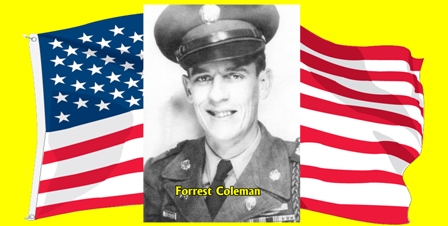
PROFILE OF A MUSEUM VOLUNTEER
Forrest Coleman was born on May 27th, 1924 in Selma, California. His family moved to Los Banos, California where he grew up and attended Los Banos High School. He enlisted in the U.S. Army on April 14, 1943, at Fresno, California and underwent processing at the Presidio in Monterey and then assigned to Camp Beale for basic training. Forrest did his advanced Infantry training at Fort Ord, California. In October 1943, he departed overseas to the Southwest Pacific, arriving in Australia November 10, 1943 and was assigned to the 32nd Infantry Division then in New Guinea in Co. L, 128th Infantry Regiment, 32nd Infantry Division. He participated in combat in several battles in New Guinea including Saidor and Aitape. Forrest departed Hollandia, New Guinea for the Philippine Islands in November 1944, landing at Leyte Island in the Philippines and was in combat until the island was secured at the end of December 1944. The invasion of the main Island of Luzon, in the Philippines, began in mid-January 1945. After two weeks of rest and re-supply, he departed for Luzon, landing at Lingayan Gulf at the end of January. While other Divisions headed South from Lingayan Gulf to capture Manila and rescue prisoners of war held by the Japanese, Forrest’s division headed North in pursuit of General Yamashita, the Supreme Commander of Japanese forces in the Philippines. Yamashita skillfully moved his main forces into the mountains of Northern Luzon and prepared elaborate defensive positions. Forrest was in combat in Northern Luzon until the war ended in mid-August 1945.
His division then
moved to Japan in the Army of Occupation and was based at Yamaguchi, Japan, on
the main Island of Honshu. In late
November 1945, he was rotated home under the points system and separated from
the Army at Camp Beale on December 18, 1945, with the rank of Technical
Sergeant and entered the Army Reserve.
He returned to active duty in the Regular Army on December 11, 1946, at
Fort Ord and departed for the European Theatre of Operations in February 1947,
arriving in Germany in late February. He
was assigned to the United States Forces at Linz, Austria serving with
Headquarters and Service Troop, 4th Constabulary Regiment (formerly
4th Cavalry) in the Army of Occupation doing various assignments. Upon returning to the United States in late
December 1949, to Fort Dix, New Jersey, Forrest re-enlisted and was assigned to
Co. F, 9th Infantry Regiment, 2nd Infantry Division at Ft. Lewis Washington.
The Korean War started June 25, 1950. His 2nd Division was alerted, prepared
for movement, and departed for Korea, with the 9th Infantry, arriving at Pusan,
Korea at the end of July. The 9th
Infantry was committed to action in early August 1950 on the Pusan Perimeter.
He fought in a number of battles on the Pusan Perimeter, the Naktong River and the
breakout North to the 38th Parallel. He served as Platoon Sergeant, with the
1st Platoon, in the rank of Sergeant First Class and was wounded twice in
action on September 1st and again September 17th.
He continued in
action, advancing across the Parallel into North Korea, into Pyongyang the
North Korean Capital, and continued on North toward the Yalu River which
separates North Korea from China. Forrest experienced battle contact with
Chinese troops after dark on November 26, 1950.
The Chinese troops were in great strength and launched a major attack on
the 9th Infantry. The United States suffered heavy casualties and were overrun.
Forrest was wounded severely that night in the right hand and left leg. He still carries a bullet in his index finger
from that battle. Forrest was evacuated
by air to a hospital at Pyongyang for two days and then on to Osaka General
Hospital in Japan. He was sent to
Letterman Army Hospital at the Presidio of San Francisco, where he recovered
and was released in April 1951. He was
then reassigned to the 30th Infantry Regiment at the Infantry School at Ft.
Benning, Georgia, remaining there until being discharged in March of 1953 with
a disability, with the rank of Sergeant First Class. In February 1951, Forrest
married his wife Florence. They have a
daughter Janet who has given them two grandsons.
Forrest was awarded
the Bronze Star Medal w/Oak Leaf Cluster, Purple Heart Medal w/2 Oak Leaf
Clusters, Asiatic Pacific Campaign ribbon w/3 battle stars, Philippine
Liberation ribbon w/2 battle stars, Korean Service ribbon with 3 battle stars,
Combat Infantry Badge w/star (2nd award), Presidential Unit Citation w/2 Oak
Leaf Clusters, Republic of Korea Presidential Unit Citation, Army of Occupation
ribbon for both Japan and Germany, Victory Medal World War 2, National Defense
Medal and Good Conduct Medal. He became
a docent at the Legion of Valor Museum in January 2000 and enjoys his position
very much. |
